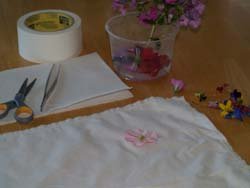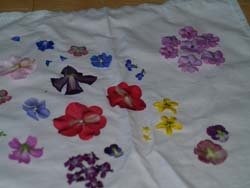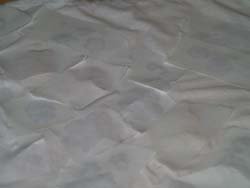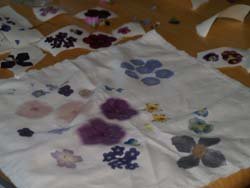





Flower Pounding, gardener's stress relief or dyeing with your garden?s bounty? Ah, perhaps a bit of both. The natural pigments pounded into properly prepared fabric can make a lovely piece of art, and allow you to let off a little steam at the same time.
To begin you need to have a piece of fabric that has been prepared for dyeing, as this is simply a method of natural dyeing. 100% cotton works best. You can either buy fabric already prepared for dyeing at most fabric stores - 100% cotton PFD - or you can prepare any cotton fabric you have by the following method:
Wash fabric in hot water using your regular detergent and two tablespoons of washing soda. Run the rinse cycle two or three times to remove all the washing soda.
Place the fabric in a large bucket. Add two cups of hot water and 1/4 cup of alum for each yard of fabric. You may need to add a little more hot water. Stir until the alum dissolves and let stand until cool.
In a separate cup mix ½ cup hot water with 1 teaspoon of washing soda for each yard of fabric, mix into water holding fabric - this will fizz a bit. Let stand overnight, rinse and spin, hang out to dry. Iron while still damp for best results.
Now that your fabric is ready, you need scissors, a pair of tweezers (handy but not imperative), a hammer, a solid surface on which to pound (and a phone book to muffle the noise a bit), masking tape to tape the flowers to the back of the fabric (I use a wide white painters tape marked “easy release”) and to gather your flowers. 

Not all flowers are suitable for pounding. Flowers with particularly thick petals such as tulips don’t work well as they tend to smear. Flowers with many petals such as roses need to be take apart so that you can pound the petals individually. Daisy like blooms need to have their centers removed and all flowers need to have stems, calyxes, pistils and stamens removed. White flowers don’t work as they have no pigment to impart to the fabric.
Flowers that work particularly well for this include phlox florets, single roses or rose petals, single impatiens, pansies with as much of the back removed as possible without destroying the flower (this takes some practice), hardy geraniums, St. Johns Wort, Forget-me-nots, any flower that can be flattened without losing the integrity of the bloom. The best time to pick the flowers is after the dew has dried, but before the heat of the day. New blooms have more color than older. You can also use leaves, and newer leaves pound much better than older, although as they age, you get the veins and edgr. es and that can be interesting. Autumn leaves will pound out interestingly, the colors being old, but newly released fom the covering of chlorophyll

Having chosen your flowers and leaves, turn the fabric upside down and lay out your “picture” arranging the flowers face down on the back of the fabric. Using the masking tape, tape the flowers down. Try to tape each flower with just one piece of tape as using more will cause minor “seams” in your flower. Of course, this isn’t always possible, so butt the tape edges when needed rather than overlapping them. This will give a less noticeable mark. 
Next, place the fabric right side up - flowers underneath - on your hard surface and pound on the right side of the fabric. I have found at this point that it is handy to have a rag or paper towel to wipe the hammer head off between blooms as some of the pigment will be transferred to the surface of the hammer. This is where the whole process can become very loud if you are using a board to pound on but you can put a phone book between the board and the fabric and this mutes most of the noise.
When you have pounded all of your flowers, remove the tape and any bits of flower or leaf that may be stuck to the fabric
Iron on both sides for two to five minutes with a hot iron (cotton setting) to set the pigments. At this point, you’ll find that the paler pinks are fading fast and that some of the yellows have pretty much disappeared. The easy solution is to pretend that you meant for that to happen, or you can use colored pencils to outline and add some subtle highlights. Most any colored pencil will work, especially those that have a softer consistency. I’ve used both cheap Crayolas and more expensive watercolor pencils with equally good results. Make sure you iron again after you use the colored pencil so that the fabric will open up to accept that pigment.
At this point, I have to admit that I don’t know how well these wash, having never washed any of the pieces that I’ve done. And I do know that they will fade, but they fade less if fortified with colored pencil. These are better used as decorative pieces than wearable art.
Ok, now you know how to pound flowers, get out there and make some noise!
(Editor's note: This article originally appeared October 10, 2007. Your comments are welcome, but please be aware that authors of previously published articles may not be able to respond to your questions.)
Copyright © www.100flowers.win Botanic Garden All Rights Reserved